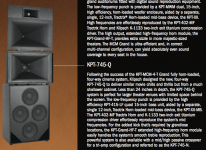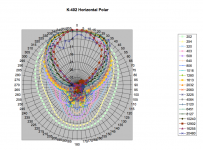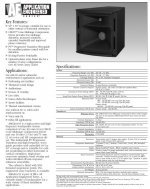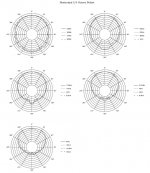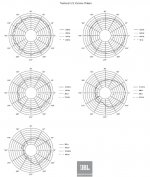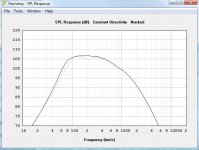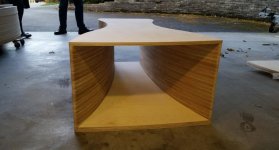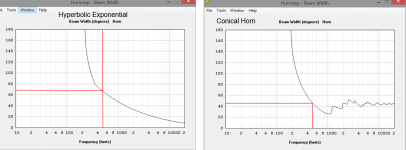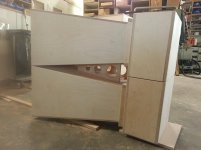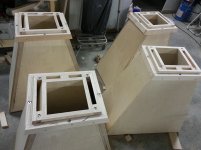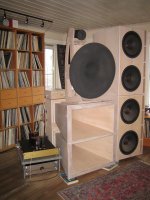I'm looking for a midbass horn that can operate in the area of approximately 80-600 Hz. I use a Klipsch K-402 top horn, crossed at 500 Hz at the moment. I would like to match its directivity (90 h x 60 v). I have several JBL 2226 in bass reflex' for the lowest frequencies and use active cross over.
I need some basic information on the cons and pros of different horn profiles for this usage and what people would recommend.
Corner horn is not an option by the way. Free standing only. Having a horn that's a little bigger then K-402 is fine.
I need some basic information on the cons and pros of different horn profiles for this usage and what people would recommend.
Corner horn is not an option by the way. Free standing only. Having a horn that's a little bigger then K-402 is fine.
Your 15" drivers already roughly match the directivity of the K-402 in the 500 Hz region. For a mid bass horn to continue to have a roughly 90 degree directivity even a single octave lower than the K-402, it's diameter needs to be roughly twice as large.I'm looking for a midbass horn that can operate in the area of approximately 80-600 Hz. I use a Klipsch K-402 top horn, crossed at 500 Hz at the moment. I would like to match its directivity (90 h x 60 v). I have several JBL 2226 in bass reflex' for the lowest frequencies and use active cross over.
Going with a horn like the KPT-XII-MB would match dispersion at crossover, but in reality not much better than the 15", though the horn depth being similar does have advantages in horizontal polar response over the front loaded 15".
My suggestion would be to use the K-402 horn itself for midbass (as well as highs), using two or four 4" to 8" drivers per cabinet, depending on your SPL desires. The dispersion will be seamless, and because the offset mid bass drivers all share a virtual point source with the HF, output will integrate at a much closer listening distance than with two separate large horns.
Art
Attachments
Last edited:
How about the current unit designed for it the Klipsch K305?
KPT-305 Theater Speaker | High Quality Cinema Audio by Klipsch®
KPT-305 Theater Speaker | High Quality Cinema Audio by Klipsch®
You should enjoy reading Pooh's Stargate 6 Horn System thread with Mid Frequency: JBL CMCD-82H, 200 mm (8 in) Dual Coil Differential Drive® transducer. JBL offers the JBL PT-K64-MHF 60° x 40° PT™ Progressive Transition waveguide. Pooh discusses other midbass horn ideas.
A little too big for my home :-(
"The satellite horns from 100 cycles up are centered on the JBL CMCD cone midrange compression drivers, That are quite spectacular in what they do in a horn system where we always have a longing to extend the midrange horn to cover the lower midrange through the vocal range but come up short using conventional compression drivers and cones. Most large format compression drivers even in the biggest most awkward horns barely make to 500 cycles and are weak below there leaving the listener with bleached out, distorted, unnatural sound lacking in tonal density and natural fundementals. The cone loaded mid drivers have the opposite problem with the cone breakup, lack of phase plugs, mass roll off, and general lack of upper range presence, power response and dynamics. The JBL CMCD82H is the answer, It addresses all the problems with the traditional compression drivers and all the problems with horn loaded cone midrange drivers all in one sleek package. Load it in a good horn and mate it with the appropriate bass, upper midrange and treble horns and you will have world class playback. "
http://www.diyaudio.com/forums/multi-way/251665-stargate-6-horn-system.html
http://www.jblpro.com/ProductAttachm...D_TechNote.pdf
http://www.jblpro.com/ProductAttachm...D_TechNote.pdf
A little too big for my home :-(
"The satellite horns from 100 cycles up are centered on the JBL CMCD cone midrange compression drivers, That are quite spectacular in what they do in a horn system where we always have a longing to extend the midrange horn to cover the lower midrange through the vocal range but come up short using conventional compression drivers and cones. Most large format compression drivers even in the biggest most awkward horns barely make to 500 cycles and are weak below there leaving the listener with bleached out, distorted, unnatural sound lacking in tonal density and natural fundementals. The cone loaded mid drivers have the opposite problem with the cone breakup, lack of phase plugs, mass roll off, and general lack of upper range presence, power response and dynamics. The JBL CMCD82H is the answer, It addresses all the problems with the traditional compression drivers and all the problems with horn loaded cone midrange drivers all in one sleek package. Load it in a good horn and mate it with the appropriate bass, upper midrange and treble horns and you will have world class playback. "
http://www.diyaudio.com/forums/multi-way/251665-stargate-6-horn-system.html
http://www.jblpro.com/ProductAttachm...D_TechNote.pdf
http://www.jblpro.com/ProductAttachm...D_TechNote.pdf
http://inlowsound.weebly.com/diy-100hz-midbass-horn.html

Could be designed for 60 x 90 by extrapolating the 402 horn dimensions, but will need a carefully designed throat--like the 402. Rounding the mouth is less critical if the horn is designed to go lower than 80 Hz. I don't see a horn that will do everything that you ask - so perhaps a build would be in order.

Could be designed for 60 x 90 by extrapolating the 402 horn dimensions, but will need a carefully designed throat--like the 402. Rounding the mouth is less critical if the horn is designed to go lower than 80 Hz. I don't see a horn that will do everything that you ask - so perhaps a build would be in order.
Last edited:
JBL 90° x 50° Coverage M + T Waveguides, JBL CMCD-82H, 8" midrange + 1.5" CD tweeter. Closer to your directivity goals.
CMCD™ Cone Midrange Compression Driver provides low midrange distortion, increased sensitivity, extended bandwidth and improved phase coherency.
PT™ Progressive Transition Waveguide for excellent pattern control with low distortion.
https://www.jblpro.com/ProductAttachments/AM6200_95.pdf
CMCD™ Cone Midrange Compression Driver provides low midrange distortion, increased sensitivity, extended bandwidth and improved phase coherency.
PT™ Progressive Transition Waveguide for excellent pattern control with low distortion.
https://www.jblpro.com/ProductAttachments/AM6200_95.pdf
Attachments
A problem I have with JBL 2226 at the moment is a steep fall from around 400-300 Hz. Maybe related to baffel step.Your 15" drivers already roughly match the directivity of the K-402 in the 500 Hz region. For a mid bass horn to continue to have a roughly 90 degree directivity even a single octave lower than the K-402, it's diameter needs to be roughly twice as large.
Using horloading is tempting though in other areas then simply matching the directivity.
It certaintly matches well when it comes to apperance. I'll take a look at it. Is there a polar of it anywhere?Going with a horn like the KPT-XII-MB would match dispersion at crossover, but in reality not much better than the 15", though the horn depth being similar does have advantages in horizontal polar response over the front loaded 15".
Pardon me but I'm not quite following you here. Are you suggesting getting another pair of K-402? And what are the 4" to 8" drivers for? Can you please elaborate?My suggestion would be to use the K-402 horn itself for midbass (as well as highs), using two or four 4" to 8" drivers per cabinet, depending on your SPL desires. The dispersion will be seamless, and because the offset mid bass drivers all share a virtual point source with the HF, output will integrate at a much closer listening distance than with two separate large horns.
Art
I'm open to anything as long as it works well. I need more explanation of cons and pros of different types.How about the current unit designed for it the Klipsch K305?
KPT-305 Theater Speaker | High Quality Cinema Audio by Klipsch®
I'm also wondering about the pros and cons regarding conical vs hyperbolic horn. Below is a picture of a hyperbolic a fellow norwegian is building now. I've attached a simulation as well showing JBL 2220 in 84 cm deep conical horn (the bottom graph) and same driver in hyperbolic horn with 100 cm depth at the top. The deep hyperbolic is more even but I don't know anything about the directivity. Any comments?
Attachments
Thanks. I'll read the thread.You should enjoy reading Pooh's Stargate 6 Horn System thread with Mid Frequency: JBL CMCD-82H, 200 mm (8 in) Dual Coil Differential Drive® transducer. JBL offers the JBL PT-K64-MHF 60° x 40° PT™ Progressive Transition waveguide. Pooh discusses other midbass horn ideas.
A little too big for my home :-(
"The satellite horns from 100 cycles up are centered on the JBL CMCD cone midrange compression drivers, That are quite spectacular in what they do in a horn system where we always have a longing to extend the midrange horn to cover the lower midrange through the vocal range but come up short using conventional compression drivers and cones. Most large format compression drivers even in the biggest most awkward horns barely make to 500 cycles and are weak below there leaving the listener with bleached out, distorted, unnatural sound lacking in tonal density and natural fundementals. The cone loaded mid drivers have the opposite problem with the cone breakup, lack of phase plugs, mass roll off, and general lack of upper range presence, power response and dynamics. The JBL CMCD82H is the answer, It addresses all the problems with the traditional compression drivers and all the problems with horn loaded cone midrange drivers all in one sleek package. Load it in a good horn and mate it with the appropriate bass, upper midrange and treble horns and you will have world class playback. "
http://www.diyaudio.com/forums/multi-way/251665-stargate-6-horn-system.html
http://www.jblpro.com/ProductAttachm...D_TechNote.pdf
http://www.jblpro.com/ProductAttachm...D_TechNote.pdf
The conical horns are usually considered to have the benefit of "constant directivity". But in this case when the mouth is small relative to the pass band they will not be. As Weltersys said, you would need a really large mouth just to get one octave deeper with same DI.
One of your "problems" is that you want to get to 80hz. This requires a horn that is about 1/4 of the wavelength at this frequency. Some people like to make them even longer for proper loading. This means something like 110cm~.
This depth means you need a super large mouth to reach your dispersion goals with a conical horn. It's simple geometry.
Myself, I would build a hyperbolic exponential and make the throat tall and narrow. (In fact I am building one myself now but only to cover 180-800hz).
That way you can get broader dispersion in the horizontal plane at the top of it's passband to kinda match the K402 in the horizontal at least. It also loads a little better down low as you can see from your own picture..
The downside is they are harder and more time consuming to build.
I think you worry to much about the lobing effect at least when it comes to reflected energy. Such a hole (limited to less than an octave) in the vertical response at this frequency will not be audible. The lobing will only be heard as a change in tonality if you move up and down near the speakers.
Do you find this troublesome today? Your 2226 stack won't be much better in this regard.
good luck
One of your "problems" is that you want to get to 80hz. This requires a horn that is about 1/4 of the wavelength at this frequency. Some people like to make them even longer for proper loading. This means something like 110cm~.
This depth means you need a super large mouth to reach your dispersion goals with a conical horn. It's simple geometry.
Myself, I would build a hyperbolic exponential and make the throat tall and narrow. (In fact I am building one myself now but only to cover 180-800hz).
That way you can get broader dispersion in the horizontal plane at the top of it's passband to kinda match the K402 in the horizontal at least. It also loads a little better down low as you can see from your own picture..
The downside is they are harder and more time consuming to build.
I think you worry to much about the lobing effect at least when it comes to reflected energy. Such a hole (limited to less than an octave) in the vertical response at this frequency will not be audible. The lobing will only be heard as a change in tonality if you move up and down near the speakers.
Do you find this troublesome today? Your 2226 stack won't be much better in this regard.
good luck
Attachments
Thank you for chiming in.The conical horns are usually considered to have the benefit of "constant directivity". But in this case when the mouth is small relative to the pass band they will not be. As Weltersys said, you would need a really large mouth just to get one octave deeper with same DI.
I think I can live with getting the same DI around the crossover (500 Hz). One octave deeper would be optimal but I don't have the luxury of that size.
Or do you consider DI down here to approximately 450 Hz more or less a waste and of no benefit?
80 Hz isn't an absolute requirement. Again, an approximate area I gave. 80 Hz would give me great flexibility. However, as you know, I can easily cross over considerably higher to my JBL 2226 towers. And most likely I will cross over in the area of 100-130 Hz considering this is an easier way to get an even response in the room.One of your "problems" is that you want to get to 80hz. This requires a horn that is about 1/4 of the wavelength at this frequency. Some people like to make them even longer for proper loading. This means something like 110cm~.
The hyperbolic you mention sounds like a good idea. May have to contact regarding it.This depth means you need a super large mouth to reach your dispersion goals with a conical horn. It's simple geometry.
Myself, I would build a hyperbolic exponential and make the throat tall and narrow. (In fact I am building one myself now but only to cover 180-800hz).
That way you can get broader dispersion in the horizontal plane at the top of it's passband to kinda match the K402 in the horizontal at least. It also loads a little better down low as you can see from your own picture..
The downside is they are harder and more time consuming to build.
I think you worry to much about the lobing effect at least when it comes to reflected energy. Such a hole (limited to less than an octave) in the vertical response at this frequency will not be audible. The lobing will only be heard as a change in tonality if you move up and down near the speakers.
Do you find this troublesome today? Your 2226 stack won't be much better in this regard.
good luck
I know I will get lobing here no matter what. And I'm not too worried about at this frequency. I'm not sure though using a dual horn (like grelv and LMC) where the idea is to use increase lobing in order to minimize reflections is something I would like to do. The frequency response in a small sweetspot isn't everything. It might also be more difficult to integrate properly. So I'm leading towards one single midbass horn. I would rather spend the money I save on better acoustic treatment.
I can't give an answer to whether lobing today is a problem or not. I would have to experience without it to pass that judgement.
Here's a compact free-standing folded horn design that will cover the 80-800 Hz (one decade) range:
https://community.klipsch.com/index.php?app=core&module=attach§ion=attach&attach_id=7987
https://community.klipsch.com/index.php?app=core&module=attach§ion=attach&attach_id=7987
Here's a compact free-standing folded horn design that will cover the 80-800 Hz (one decade) range:
https://community.klipsch.com/index.php?app=core&module=attach§ion=attach&attach_id=7987
Not sure that I would consider the Jubilee a compact size. I prefer folded horns in the style of the University Classic opposed to the bifurcated Klipsch style. The primary issue with the bifurcated style is you get frequency ripples at multiples of the distance between the two exits.
Sounds close to what I've been thinking, but I'd like to get up to 750hz and flat down to 100hz.
A straight front horn like in post #16 above.
B&c 8's or 12's with high mass corner.
114cm deep (1/4 wavelength of 75hz, 1/2 octave below the mouth cutoff).
And I figure a mouth of 6ft2, because free air should need 8ft2 and if the mouth was emptying out in the middle of the floor it'd need 4ft2.
But if someone could simulate it for me, please ?
A straight front horn like in post #16 above.
B&c 8's or 12's with high mass corner.
114cm deep (1/4 wavelength of 75hz, 1/2 octave below the mouth cutoff).
And I figure a mouth of 6ft2, because free air should need 8ft2 and if the mouth was emptying out in the middle of the floor it'd need 4ft2.
But if someone could simulate it for me, please ?
Last edited:
mine are 87cm effective length
throat 20x20cm and mouth 40x70cm
cavities are for sandfilling
stacked they´re flat from 70-550, only lo-passed 24db oct
acoustic hi pass really steep
rear chamber 40x40x20cm
112db
Hornresp basically nailed it
best
Leif
throat 20x20cm and mouth 40x70cm
cavities are for sandfilling
stacked they´re flat from 70-550, only lo-passed 24db oct
acoustic hi pass really steep
rear chamber 40x40x20cm
112db
Hornresp basically nailed it
best
Leif
Last edited by a moderator:
The ripples you mention are frequency dependent - if you cross at a lower frequency, the two mouths will not diffract. The K-402 with compression driver easily loads down to 450 Hz--in fact, the same horn itself is used in a K-305 midbass horn loads to 150 Hz, which would be a solution to the OP's questions if he has even considered it. It was mentioned in another forum but no word from the OP on why that design isn't coming into solution.Not sure that I would consider the Jubilee a compact size. I prefer folded horns in the style of the University Classic opposed to the bifurcated Klipsch style. The primary issue with the bifurcated style is you get frequency ripples at multiples of the distance between the two exits.
What kind of straight midbass horn is compact, assuming you're designing to the specifications listed above by the OP (80-600 Hz, 60 x 90 degrees coverage, freestanding--no boundary effects)? The linked bass bin is the only one that I've seen that does that--when used in freestanding applications.
Last edited:
I have not seen a polar map of the Klipsch KPT-XII-MB mid bass horn.I'll take a look at it (the Klipsch KPT-XII-MB). Is there a polar of it anywhere?
Pardon me but I'm not quite following you here. Are you suggesting getting another pair of K-402? And what are the 4" to 8" drivers for? Can you please elaborate?
I was suggesting using your K-402 as a Synergy horn. To extend the response down only an octave could use small drivers with small port holes, to go down to 80-100 Hz would require larger drivers and larger holes and bass reflex porting.
As you can see in this thread, using some 10" on a smaller horn than yours gets response below 100 Hz, though requires EQ. Your wider vertical dispersion will not load as low as my more narrow vertical dispersion conical horn.
http://www.diyaudio.com/forums/multi-way/262838-synergy-tripp-10-a.html
Since you really only need another octave or so more mid response to work well with your 15"s, it would be quite simple to add four sealed back midrange to the K-402 horn. Hole saw, a little bit of filing and sanding, screw on the drivers, could be done in an afternoon of work, though the driver decision seems to take most of the Synergy builders an inordinate amount of time
Art
- Home
- Loudspeakers
- Multi-Way
- Pros and cons of different midbass horns
